|
|

 James Monroe (the fourth Virginian president!) 1817-1825 James Monroe (the fourth Virginian president!) 1817-1825  The economic Panic of 1819-1821 The economic Panic of 1819-1821 Florida Florida  The Missouri Compromise (1820) The Missouri Compromise (1820) The "Monroe Doctrine" (1823) The "Monroe Doctrine" (1823) Monroe's final years as president (1823-1825) Monroe's final years as president (1823-1825)  John Quincy Adams – President (1825-1829) John Quincy Adams – President (1825-1829)  The tough question of Indian vs. Anglo land rights The tough question of Indian vs. Anglo land rightsThe textual material on this webpage is drawn directly from my work America – The Covenant Nation © 2021, Volume One, pages 210-220. |

|
|
James Monroe (the fourth Virginian president: 1817-1825)
In December of 1816 the electoral college gave a complete thrashing to the dying Federalist Party when it elected the Jeffersonian Republican James Monroe to the presidency by 183 votes in his favor, against only 34 votes for the Federalist Rufus King of New York. Monroe was not an exciting politician. But he more than made up for his lack of charisma with his personal dedication to the young American nation that he had served so well. He served in Washington's army and took part in many of the famous battles of the War of Independence, rising to the rank of colonel before he resigned his commission to study law under Jefferson. He would follow in the footsteps of Jefferson, becoming America's minister to France, then governor of Virginia. He then became President Madison's secretary of state, and thus a natural choice of the Republicans for the presidency when Madison indicated his intention to step down from the presidency after two terms. America relaxed greatly in finally finding peace with England and France in 1815, producing a lively sense of optimism which in turn in 1817 prompted a Boston newspaper, the Columbian Centinel, to entitle the new post-war period the "Era of Good Feelings." Yet there were a number of problems still facing the country. |
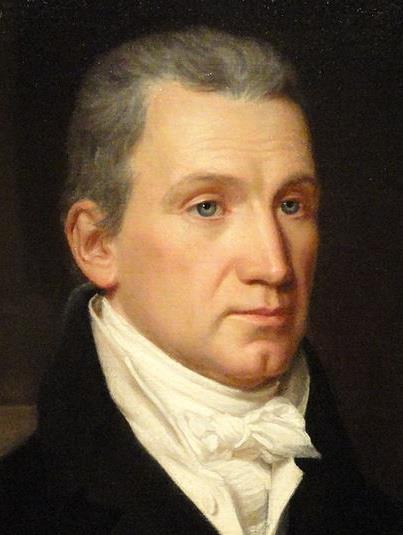
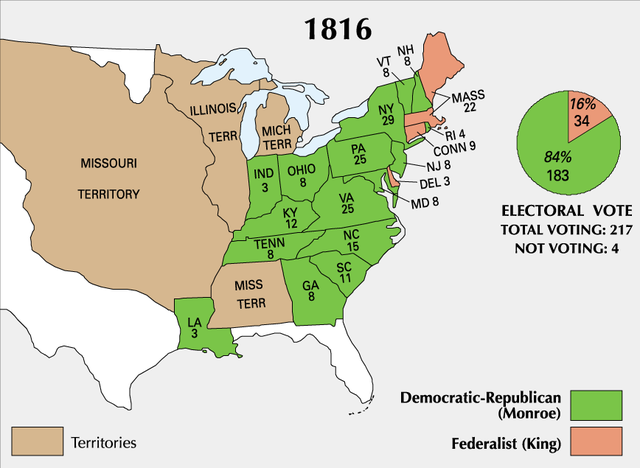
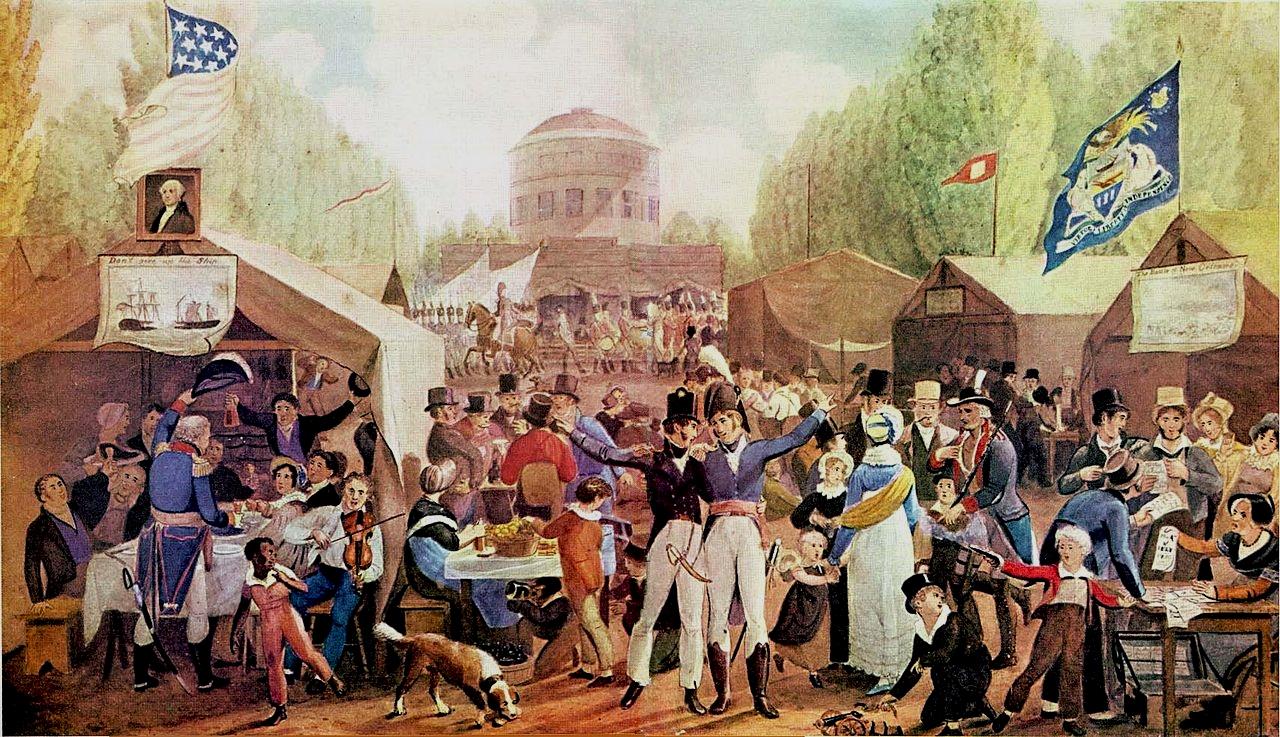

|
|
The biggest problem the nation faced at this point was the state of the
nation's economy. The war had thrown the government treasury into deep
debt, a debt financed largely
by the government's borrowing from a number of private banks. This
borrowing in turn flooded the economy with new bank notes, producing a
currency inflation that threatened the financial stability of the
country.
Furthermore, the private sector was in just as much trouble. With the end of the Napoleonic wars in 1815, the demand in Europe for American agricultural goods, which had produced much of the prosperity of the Era of Good Feelings, dropped away rapidly (European soldiers had returned to their farms, thus ending the demand for American farm goods). The price of farm products faded away in America, leaving farmers unable to pay the debts they had acquired in buying more land to meet the former high European demand. Land prices also fell as farmers scrambled to sell off some of the land they had purchased. Banks that held farmer's mortgages soon also found themselves in trouble as well, the banks demanding from the farmers cash payments, cash which the farmers simply did not have. The bankrupt farmers being forced to turn their land titles over to the banks was no help to the banks, as the land was now valued at much less than the original loans the banks had extended to the farmers. Also, people now began to make a run on potentially troubled banks, demanding specie (gold or silver) for the bank notes issued previously by the banks. As the banks had issued paper notes ten times the value of the metallic specie they held in their vaults, they were simply forced to shut down. By 1819 and 1820, banks, farms, and other businesses were closing down everywhere. Understanding the economic dynamic
This was the first major panic, like those that would hit the country at regular intervals, such as in 1837, 1857, 1873, 1893, and 1907. The pattern of the 1817 panic was also very similar to the one that developed within rural America just after World War One (1919-1920) when American farmers and their banks found themselves in exactly the same situation. And there were similar elements in the situation during the 1930s Great Depression when American manufacturers found that the market for their new consumer goods was saturated, most Americans now possessing the radios, cars, sewing machines, washing machines, etc., that had the industrial market running so hot in the 1920s. It is the very nature of venture capitalism to get caught up in these wild swings of fortune, especially because of the aggressive – and risk-taking – nature of capitalism itself. A capitalist economic system is shaped very heavily by the personal economic decisions that the individual members of society themselves make. At the same time, the system is subject to unpredictable forces, simply because there are so many forces at play in a free or open national economy. But history has demonstrated over and over again that it is better to let those mysterious factors play out than to try to bring them under the mastery of some small group of enlightened economists or social planners. Such Socialism, in trying to bring these mysterious social and economic forces under human control, simply ends up snuffing them out. Invariably Socialism brings into being the most oppressive and impoverished of all economic systems. Of course, some moderate amount of governmental refereeing of the economic game played in a market open to all private producers and consumers is wise. But the governing referee must never start trying to play the game itself or the game will simply stall. This would be, after all, just another version of Socialism. Actually, in 1816, just prior to the outbreak of the Panic, Congress had voted into existence the second Bank of the United States in order to bring the economy under some kind of stricter management. Eventually the financial discipline that the BUS imposed on the nation (tightening the country's money supply) brought down the inflation, and helped stabilize the value of the nation's currency. At first this intervention merely deepened the crisis, leaving many businesses, large and small, facing collapse when they could not repay the cheap money they had borrowed earlier with the money now due on their loans, money (especially silver and gold coinage) that was now much more scarce and thus more expensive for them. Then when in early 1819 American cotton prices crashed as a result of the British purchase of cotton from India, panic set in. But the BUS did not let up on its tight money strategy, despite the country's economic reversal from inflation to deflation. Finally the economy settled down and began to revive, though less from any activity of the BUS than from the availability of new Mexican silver to back an expansion of America's money supply in metallic specie. But not surprisingly, as with the first BUS, the second BUS would come under the intense dislike of America's vast legion of farmers – who, as always, loved cheap money and inflation since it allowed them to repay their mortgages and other operational loans much more easily with cheaper or inflated dollars. Besides, to their way of looking at things, the banking world was simply the tool of wealthy exploiters operating out of the industrial East. Thus sadly, the stumbling economy, and the government's efforts to revive it, had undermined the spirit of national unity produced by the war, and revived the old sectional rivalries that divided the country.
These events would also split the Republican Party
into the New Republicans (in many ways similar in their economic and
political philosophy to the former Federalists) and the
Democratic-Republicans (closer to the original Jeffersonians). These events would also bring the short-lived Era of Good Feelings to an abrupt end. |
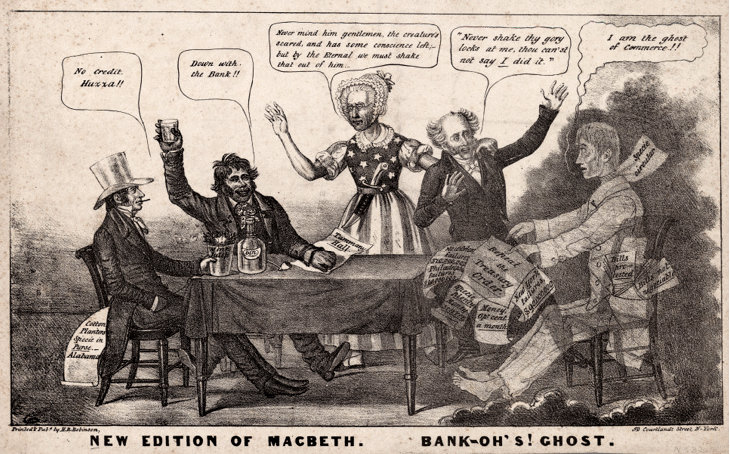

|
| The
Napoleonic Wars of 1800-1815, during which Spain had been torn between
French efforts at political control of their country and desperate
Spanish efforts to throw off the French grip, had left Spain greatly
exhausted. As a result, Spain proved to be powerless in its efforts to
head off independence movements among its Spanish colonies in America
(for example, Mexico, Colombia, and Argentina) which erupted during
this period. And where Spain continued after the war to hold on to some
kind of position in America, that hold was very weak. This certainly
was the case in Florida.
Seminole Indian raids from Spanish Florida into Georgia and Alabama ultimately decided the fate of Florida. Because of these raids, American Secretary of War John C. Calhoun in late 1817 ordered the hero of New Orleans (and Horseshoe Bend) General Andrew Jackson to take action with respect to the Seminoles. Jackson interpreted this as being more than a call for the defense of the American borders. With the coming of the next spring (April and May of 1818) he invaded Florida, not only decisively defeating the Seminoles but seizing all of Spanish Florida, declaring it to be thus a territory of the United States. President Monroe and his secretary of state, John Quincy Adams, were embarrassed. But the American nation was thrilled by Jackson's heroics. Spain at this point decided that wisdom called simply for the sale of Florida to the United States (for the price of $5 million) confirmed in the Adams Onis Treaty of 1819. With the American payment in 1821 of that sum, the United States in fact came into undisputed possession of Florida. |
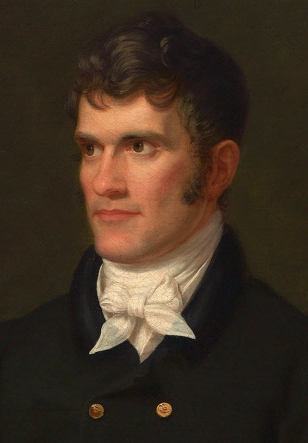
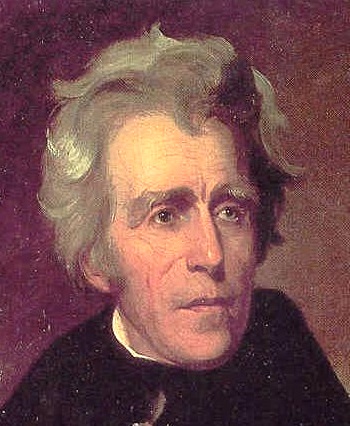
John
C. Calhoun (Secretary of War)
General Andrew Jackson
| Calhoun ordered Jackson to protect Americans from Seminole Indian raids coming from Florida. Jackson took that as authorization to invade Florida in 1818 and destroy Seminole power. The embarrassed Spanish then simply sold Florida to America for $5 million! |
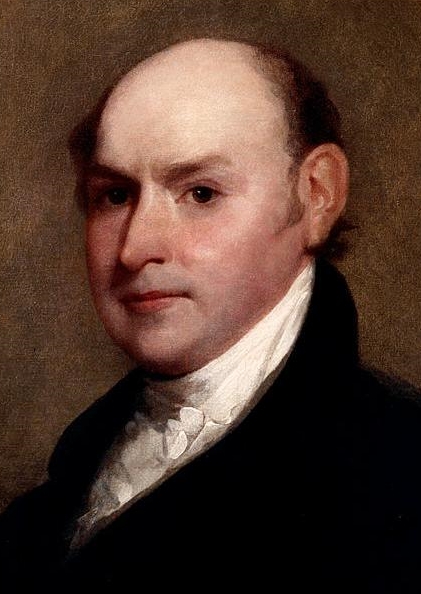
Secretary of State John Quincy
Adams – by Gilbert Stuart (1818)
The White
House

|
| In
1819, Missouri applied for statehood, opening up a bitter controversy
arising from the question about whether Missouri would enter the Union
as a slave or free state. At this point there was a balance of eleven
free and eleven slave states making up the Union. But the balance was
precarious, stirring fears of the Southern slave states that adding
more states would swamp them in an anti-slave mood arising from the
North. Slavery had been forbidden in the states of the Northwest
Territory. And Louisiana had been admitted in 1812 as a slave state,
and thus there was some kind of expectation that future Southern states
would join the ranks of the slave states. But Missouri was a border
state, with slavery practiced in parts of the state, but not in others.
Was Missouri thus to be considered slave or free?
The Constitution itself made no mention of the issue, although one of the last acts of the Continental Congress in 1789 was to set up the Northwest Territory as a free zone forbidding slavery, indicating that the federal Congress might have such authority as well concerning the admission of territories as new states. The Southern states claimed that the issue was entirely a state issue, not a federal issue; each state could of its own decide whether it was to be a slave state or not. Nonetheless, slavery was not really a legal issue as much as a deep moral issue, with slavery clearly coming under ever deeper moral questioning.1 This made the Southern states all the more uneasy, because the lifestyle, the Southern fantasy of living the life of plantation aristocracy, as well as the tobacco/cotton economy itself was completely dependent on the institution of slavery. There was no longer any talk in the South about the institution simply withering away by itself. Indeed, any talk of limiting the institution was taken as an insult or threat to Southern culture. But the North was deeply involved in a spiritual movement of Christian revival, in which slavery certainly appeared to be one of the sins of the nation that needed cleansing. The abolition of slavery was indeed soon to become a major topic of conversation in the North, a conversation that made the South very nervous. On top of this, the population of the North was expanding much more rapidly than that of the South because the freer culture made for greater personal opportunity. It thus drew adventuresome Americans – and even Europeans – to the North rather than the South for settlement. All this tension came to a head with the question of admitting Missouri as the twenty-third state. But then Maine requested entry into the Union as a new state, and the possibility of compromise seemed to present itself. Henry Clay – the Great Compromiser
Henry Clay of Kentucky stepped forward to offer specifics as to how this compromise might be achieved. As a package deal, Clay proposed admitting both states – one slave, one free – thus preserving the balance, coupling this with the stipulations that a line would be drawn across the country at the 36°30' parallel running west from the Mississippi River, distinguishing future slave and free states. This would run along the southern border of Missouri, but exempt Missouri, allowing it to be admitted as a slave state. He added also the provision that the property interests of Southern slave-owners would be fully protected, including the return of runaways and the ability of Southerners to travel north with their slaves without the fear of the legal loss of their slaves once in the North. And he cleverly bundled this as a single proposal so that it could not be amended by those wanting to pick its provisions apart. At the time this compromise seemed to be a brilliant solution to the problem, which many hoped would now go away as an issue. But Clay's compromise did not solve the problem. Instead it brought out into ever-stronger light the deep moral-cultural division separating the North from the South, a division that clearly was not going to go away on its own and indeed would only grow larger with the recurring matter of the country's taking in new states to the West. 1Prior
to the War of Independence – even during the Great Awakening of the
mid–1700s – most Americans avoided the issue concerning the evils of
slavery, even as an additional 150,000 slaves were imported to America
from the 1720s to the 1760s. But the Quaker John Woolman took up the
cause in the 1740s, and in 1758 was instrumental in getting the Yearly
Meeting to set up a committee to look into this issue. But this was
merely a very slow start of what eventually would become Abolitionism. |
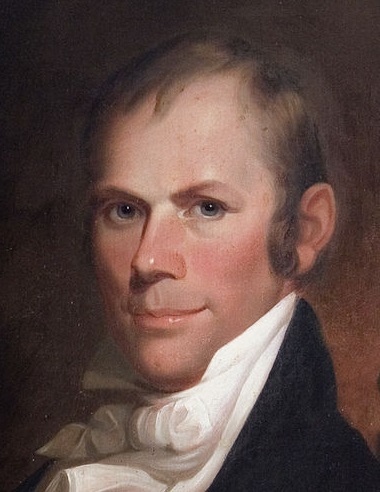
Henry Clay -
"The Great Compromiser" – by Matthew Haris Jouett (1818)
Transylvania University – Lexington, Kentucky
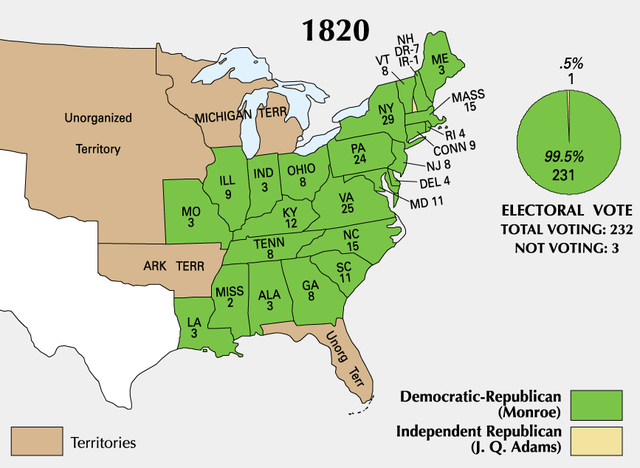

|
| Meanwhile,
with Spain caught up in a struggle at home in Europe between
Republicans and Monarchists, Spanish power overseas in the Americas
was clearly slipping. After ten years of struggle, New Spain or
"Mexico" finally (1821) secured its independence from an exhausted
Spain – with Central America following right behind.
When in 1822 France, backed by other monarchs of continental Europe, moved to oust a constitutional republic in Spain and restore the country to monarchy, concern developed in America that Spain, or even (and more likely) France, might want to impose imperial rule in the Americas again. But Britain was just as alarmed as America about this. Britain had its own reasons for not wanting to see this happen. Britain was always suspicious of any rising European power that might upset the balance of power on the continent and overseas, for such a development would usually end up isolating Britain from the rest of Europe (and from the lucrative overseas trade that Britain's economy depended on), always a dangerous position for Britain to find itself in. Britain had been developing growing commercial relations with the newly independent republics of the former Spanish (and Portuguese) Empires in America, which they did not want to lose through a renewal of Spanish (or French) imperial or mercantilist designs2 on the Americas. Thus it was that British Foreign Secretary Canning inquired of Monroe's secretary of state, John Quincy Adams, the son of the former president, John Adams, about America's interest in a policy of blocking the restoration of European imperialism in the Americas. It was understood that the British navy would be ultimately the enforcing agency of such a policy, but without any formal connection (which might also stir up accusations about Adams being pro-British). The answer was in the affirmative, and took the form of a message to Congress by Monroe in 1823 (actually written by Adams), in which Monroe made it clear that the Americas had a destiny separate from Europe's, and America would defend that separation by whatever means necessary. European monarchs scoffed at Monroe's presumptuousness, but in fact were well aware of the reality of British interests behind this pronouncement and did not actually challenge it. 2Mercantilism
was commonly practiced in European imperialism, in which only the
European mother country was allowed to trade with its overseas colonies.
|
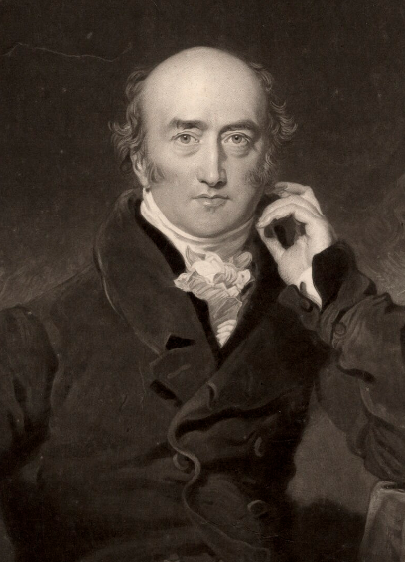
|
| And
thus it was that Monroe finished out his presidency in 1825 with the
country once again in excellent shape. The economy was booming with the
expansion of American industry and trade, the American population was
expanding to lay full claim to its western territories, and America
found itself in no major crisis with one or another of the major
European powers. The Era of Good Feelings had been restored!
The election of 1824. With the collapse of the Federalist Party, the American two-party system had thus also collapsed, complicating greatly the selection of candidates for the presidential election. The Republican Party itself was consequently split into a number of contending factions, built mostly around prominent personalities, the various geographic regions that supported them, and the spoils system of political rewards that generated widespread personal support for the leaders in Washington (with the notable exception of John Quincy Adams who found such political wheeling and dealing to be personally distasteful). Four different candidates presented themselves for the presidency, John Quincy Adams, William Crawford, Henry Clay and Andrew Jackson. As a consequence, none of them received a majority vote (at least 50 percent of the total vote) and the election of the president (according to the Twelfth Amendment) was given to the House of Representatives to decide. But only three candidates were eligible for consideration under the provisions of the Twelfth Amendment. Jackson had received by far the most popular votes of the four (though only a small plurality in the electoral college) and was expecting the House to elect him. Clay, who was the fourth in the electoral count and thus not eligible for House consideration, nonetheless commanded considerable power in the House of Representatives as its Speaker. Clay personally disliked Jackson and was closer to Adams in political thinking. He convinced his supporters in the House to vote for Adams, giving Adams a full majority on the first ballot, and thus the presidency. |
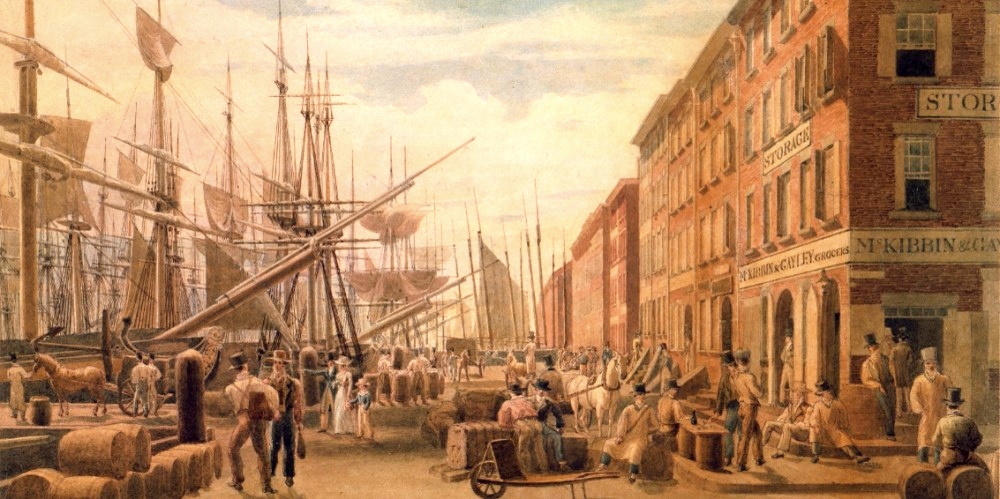
Prosperity had returned to the country ... and indeed it was finally an "Era of Good Feelings"

|
| Then
when Adams named Clay to be his secretary of state (so far, the one
position that seemed a natural stepping stone to the presidency),
Jackson exploded in fury. He claimed that the deal was simply a corrupt
bargain,3 and hammered away on that claim for the next four years.
John Quincy Adams was much like his father, John Adams, lacking personal charm or charisma, but possessing a brilliant mind and a strong moral character. He did not particularly like politics, or even the office of presidency, and did very little to build up a corps of political support beneath him. He preferred to focus instead on programming various physical and intellectual improvements for the nation, from roads and canals, to the encouragement of industry, to the advancement of education, to the support of the sciences. He worked hard to reduce greatly the national debt. But he faced tremendous opposition from Jackson and his supporters in Congress on every one of his programs. He did not have an extensive foreign policy program to deal with because as the former secretary of state he had overseen tremendous improvements in the country's international position. He also believed that it was America's duty to not act the part of an ambitious imperialist nation, but instead to focus on the development of the Republic at home. He tried to be fair in the handling of the nation's relations with the Indians – especially concerning the land rights of the large Cherokee nation in the American Southeast.4 But on this issue Jackson's opposition was extremely strong, as this was a matter of great interest to Jackson's natural constituency of Southern and Western Whites, who were demanding that the Indians be removed to a location somewhere West of the Mississippi River. Overall, John Quincy Adams, though an excellent administrator as U.S. president, was sadly out of touch with a dynamic America, which others, such as Jackson, understood instinctively. Thus Adams would serve only one term as president. 3This was quite an unfair accusation, as Clay was an outstanding statesman, very well suited for the job. Jackson's team in fact had also courted Clay in the hopes that he would swing his votes in the House towards Jackson. Part of Jackson's fury was a result of Clay's earlier strong stand in Congress against Jackson's invasion and grab of Florida. 4The Cherokee had gone to great lengths to accommodate themselves to Anglo culture, most of them becoming Christians and giving up their hunting economy to become settled farmers like the Whites. Although they presented no danger to the Whites, Southern Whites could not get past their general hatred of all Indians – or anyway the general hunger to confiscate Indian lands.
|
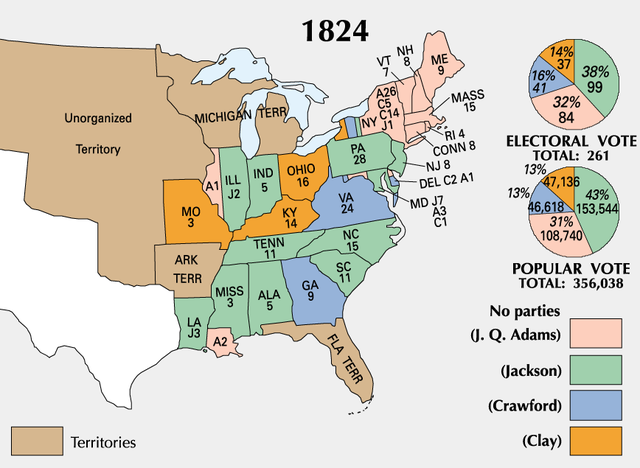
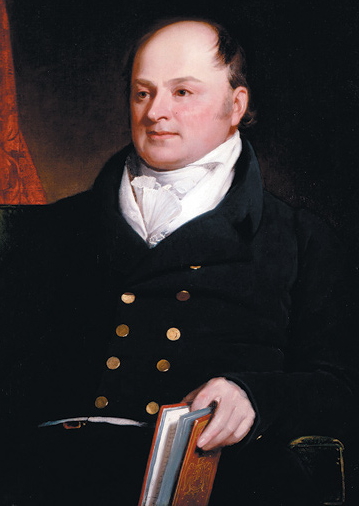 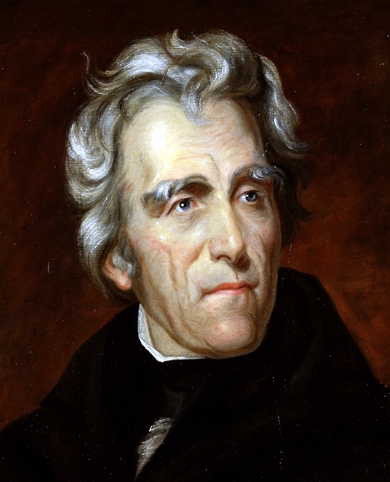 John Quincy Adams Andrew Jackson 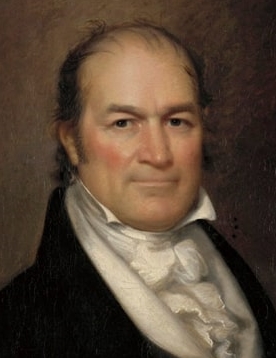 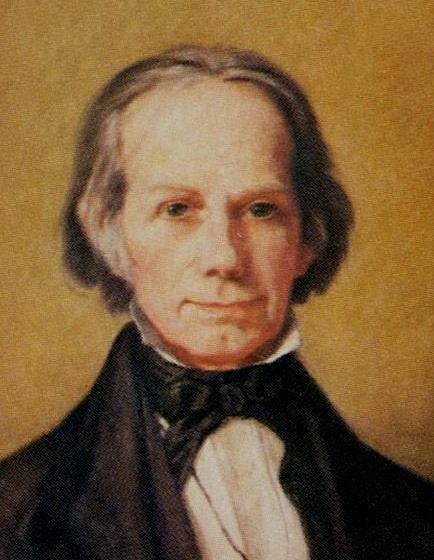 |
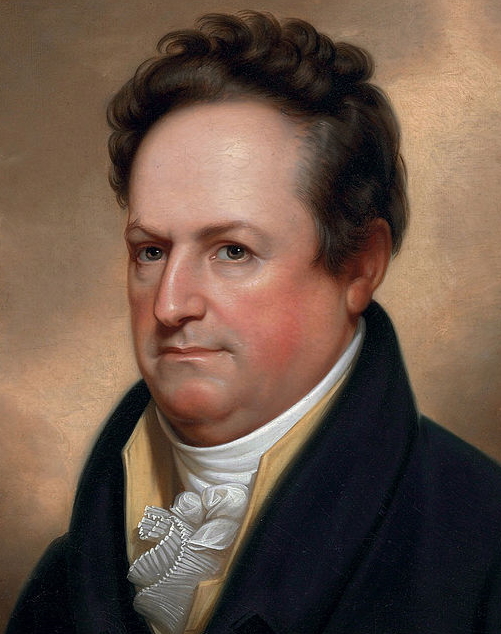
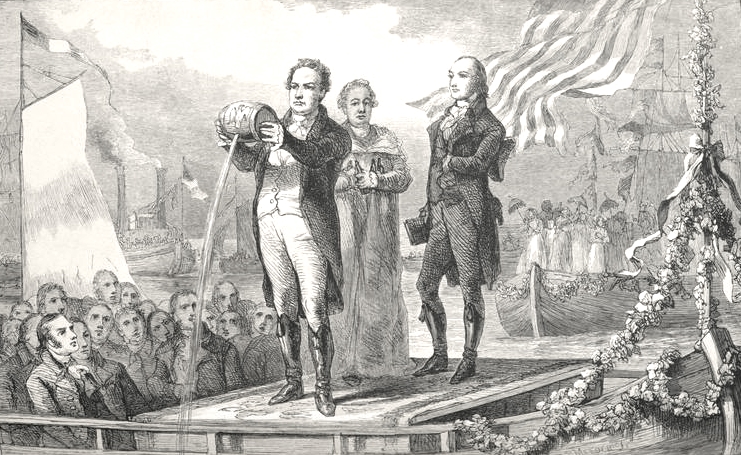
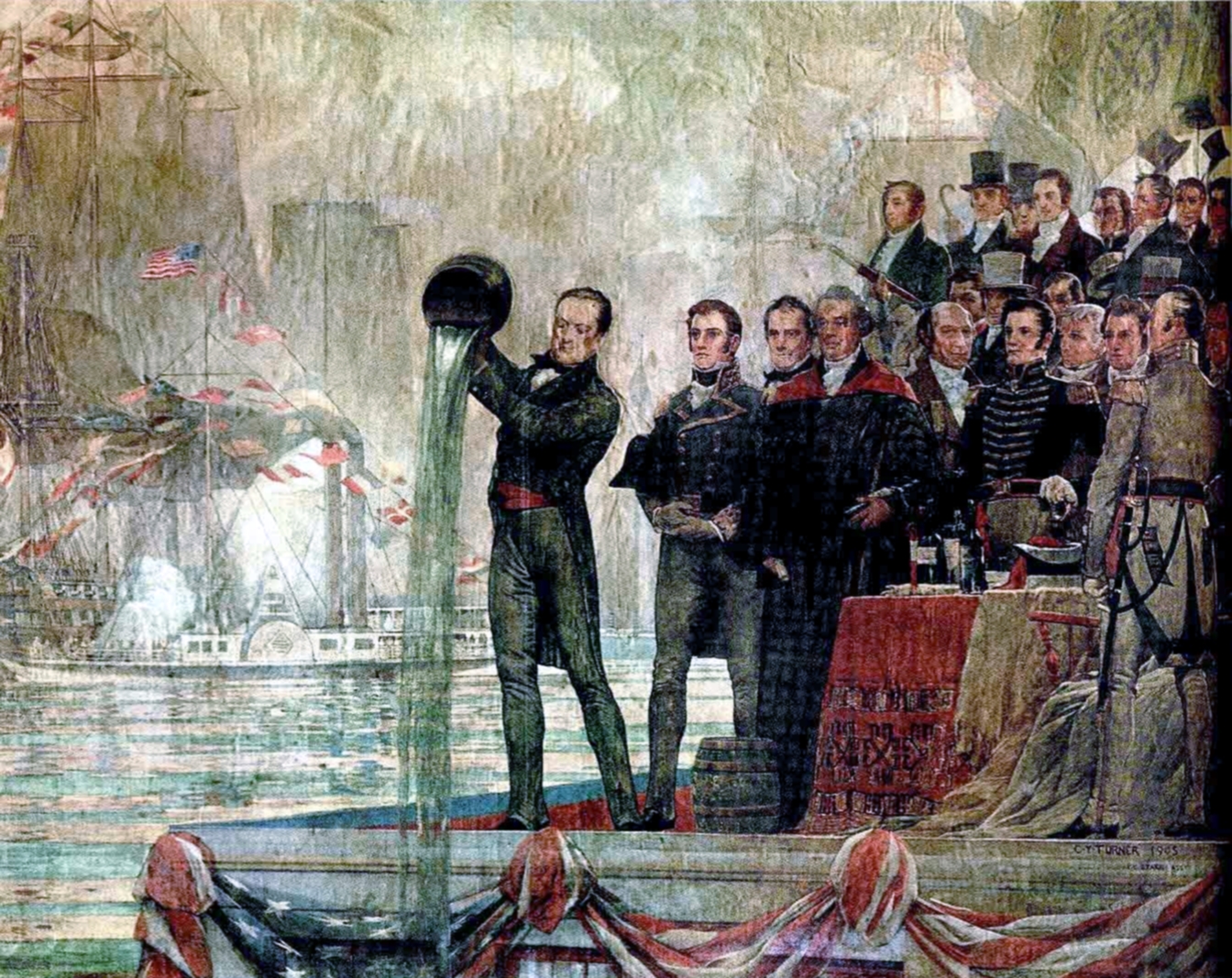
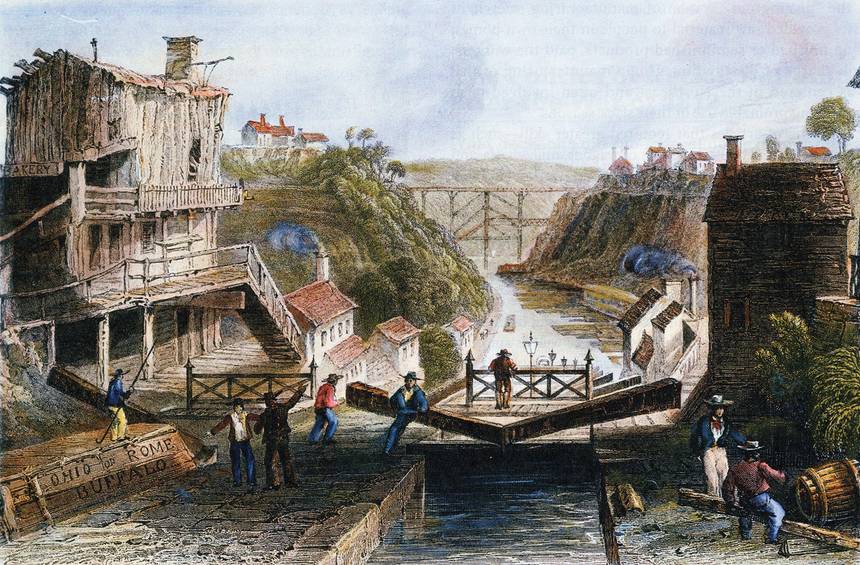

|
|
The English/American understanding of land ownership
Land – Indian land – had long been a big part of America's sense of personal salvation. Americans understood that God saved the soul. But they also understood that land saved the body! From the very moment that Americans landed on the Atlantic or Eastern shores of North America they had developed a very strong interest in the land, the low mountains and dark forests that lay just to the West of them. The Indians who lived on that land were not numerous and thus the lands seemed virtually empty, just waiting for the English colonists to come and settle there. At first the English settlers and Indian hunters attempted to stay on friendly terms with each other. But their concepts of land ownership were so different that conflict – deadly conflict – was inevitable. To the English, land ownership was demonstrated in a person's working of that land. Whoever cleared the land, cut back the forest and planted crops in these new clearings could claim unchallenged title to the land. Idle land, land that was not farmed or grazed, was not owned by anyone. Indeed, unfarmed land was simply uninhabited land. Thus the Indians as hunters requiring the woodlands for the survival of the game they hunted just did not factor into the English understanding of things. To the English way of thinking, Indian land was simply there waiting for the taking by some industrious individual. But according to the Indian way of thinking, the land was there for hunting, not farming – and the English were no more than thieves, stealing their land. In this contest for the land the Indians were technologically, numerically, and socially greatly outmatched. Not only did the English settlers possess superior weapons, they also had more highly disciplined or unified social power. The Indians were not only small in number on the land, they were highly divided among themselves – ancient enemies, one small tribe against another. The Indians thus were tremendously handicapped in their efforts to hold back English expansion into their ancestral territories. Consequently, by the early 1800s, the expansion into the Indian lands of the West and South by land-hungry Anglo-Americans was rapid. There had been efforts from time to time, even from the beginning of the earliest English settlements, to legalize or regularize this question of land ownership. For the English this was done through written legal assignments of the land in the form of deeds. Such legal assignments not only awarded ownership to an individual but also to that individual the rights of transfer of that land to another – as a grant (often in marriage, often as the terms of peace after a war) or as a sale. Treaties as a follow-up to a war very often included the idea of the transfer of land from one individual (a king, for instance) to another.
The weight or worth of treaties
Indians were aware of such arrangements – entering into arrangements among themselves similar to the European concept of treaty. And thus on many occasions the English and tribal chiefs transacted land deals – that is, entered into treaties with one another. The Dutch thus purchased the island of Manhattan for their New Amsterdam, and Roger Williams also purchased from the local tribes the land at the head of the Narragansett Bay for his Providence Colony. But in general, even this nicety was ignored by the English who pushed into Indian lands to make way for their own settlements, unaware of or ignoring the Indians' land rights. There often were treaties signed between the English and the Indians – usually following another bitter conflict or local land war. These treaties usually simply acknowledged another loss of land by the Indians, though they were frequently accompanied by some comforting section which recognized the rights of the same Indians to other, uncontested territory. But treaties back in Europe among kings had very little longevity – quickly broken by their kings at the earliest opportunity. And so it was with the treaties the English signed with the Indians. These agreements were treated with the same lack of sense of anything permanent about them. This the Indians did not understand, for their idea of a treaty was that it formed a perpetual or permanent right to land use, one that would be handed down as a matter of honor by generation after generation. Sadly, the Indians were to learn that things just did not work this way with the English. Besides, frontiersmen paid little attention to the land arrangements entered into with the Indians by their colonial governments. Such governments were far away and the local frontiersmen lived in a world far removed from the halls of the colonial governments. Frontiersmen conducted their own affairs pretty much as they saw fit, regardless of what the colonial authorities had agreed to.
The Christian understanding of all this
Why didn't Christianity soften this kind of hard-handed land seizure? Christians after all were instructed by Jesus to love their neighbor as themselves. But their Bible also told them of the command of God to the Israelites to enter the land of the Canaanites and clear it of both the people and even the herds and flocks of the Canaanites. This was a necessary precondition for God to be able to settle the Promised Land with his Chosen People. Of the two viewpoints, Christlike love or Israelite aggression, when it came to dealing with the Indians, the tendency of Christian America was to take the Old Testament approach. Christian Americans generally saw themselves under the same instructions by God to clear the land to make way for the People of God.
The huge demographic or population pressures behind the expansion
Anyway, whatever the legal or moral points involved in this takeover of the land, there was little likelihood that the Indians were going to be able to hold back the flood of Europeans into their tribal territories. Since the late 1300s the European population had exploded and land hunger in Europe was very intense. This was the case not just in England but in the Netherlands and in German-speaking central Europe. The English first attempted in the 1500s to put excess population in Ireland, this being justified in the English mind by the primitiveness of Irish society (in the same way English land settlement would soon be justified in America). But some of this Irish land soon filled up with settlers from Scotland – the Scots-Irish – who in turn (by the early 1700s) would push on to America and become major settlers along the American-Indian borderlands or frontiers. Even by the time of American independence, numerous European settlers in America had left the coastal lowlands along the Atlantic coast and were settling in various places in the Appalachian Mountains to the West. Some had even crossed those mountains and had begun to settle in the rolling hills of Kentucky and Tennessee to the West of the Mountains. As we have seen, one of the last tasks of the Continental Congress in 1787 was to design an orderly system of settlement of the land in the Northwest Territory awarded the Americans in their peace settlement that ended the War of Independence with the English. Swift action was required to get settlers into these territories – before the English found some new excuse to break the peace treaty with the Americans and seize these lands again. Of course, the Indians were not consulted in this matter. They, as "savages," counted not at all in the plans to map out a program of systematic land development in the West. And now that the legal reach of Anglo-America extended, through the Louisiana Purchase, even to the Rockies (and possibly beyond), life was going to become very tough for the American Indian. |


 Miles
H. Hodges
Miles
H. Hodges